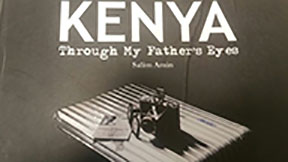“Filming on the winning side”. Kenya through the lens of Mohamed Amin (1943-1996)
 Recently the library of the African Studies Centre Leiden purchased “Kenya: through my father’s eyes”, number 338 of a limited edition of 2,000 copies by Salim Amin. The book is dedicated to his father, Mohamed Amin (1943-1996), arguably the best documented African photographer and journalist ever.
Recently the library of the African Studies Centre Leiden purchased “Kenya: through my father’s eyes”, number 338 of a limited edition of 2,000 copies by Salim Amin. The book is dedicated to his father, Mohamed Amin (1943-1996), arguably the best documented African photographer and journalist ever.
China Global Television Network devoted an issue of “Faces Of Africa” to Mohamed Amin (see the video below), positioning him on a par with politicians like Kwame Nkrumah,Thomas Sankara, Jomo Kenyatta, and African artists such as Fela Kuti and Wole Soyinka. In 2006 his son Salim produced the documentary “Mo and Me”. The making-of was documented in al Jazeera’s programme “Rewind” (see the lower video). Many of Amin’s pictures appear in the Leiden collections (see for example the “Cradle of Mankind”) and his contribution to our understanding of major events in African history can hardly be underestimated. Therefore when Salim Amin, as of 2008 chairman of Camerapix, Founder and Chairman of The Mohamed Amin Foundation, and Founder of A24 Media, published “Kenya through my Fathers’ eyes” in a limited edition, we bought a copy. Watch a video of the making-of this special book.

Father and Nation
The book is neither a biography of Amin, nor a history of Kenya, but it is an affectionate tribute to both: the father and the nation. It contains a small selection of the four million stills Amin left behind as his legacy when he was killed in 1996 when his flight was hijacked and crashed. In short chapters, several of them introduced by a quote from Salim remembering his father, icons of Kenya are shown in pivotal moments as well as in more mundane activities: the burial of Mzee Kenyatta, Tom Mboya playing football or Odinga enjoying a Kikuyu dance. Wildlife is represented by elephants, rhino’s and lions, whereas rally cars, athletes and race horses illustrate Kenian sports during the twilight of the empire and the birth of a nation. The visits of (many non-African) celebrities ranging from Queen Elizabeth via the Pope to Jackie Kennedy, cover more than 40 pages. Chapters on Lamu, Turkana hunters and voodoo followed by Goddard’s Small Astronomy Satellite project lead to a final pictorial conclusion in which Kenya’s contribution to modernization is demonstrated by pictures of the East Africa Portland cement Factory, Land-cruisers assembling plant and the pan-African Paper mills.
Multimedia book
Apart from some unpublished photographic material, the most interesting thing about the book is that it has incorporated 12 Augmented Reality videos within the pages of the book. With the free HP reveal app installed and after moving your smartphone over some of the pictures, short historical videos are played. This is the first book in our library making use of the technical opportunities to mutually reinforce different media. The unrivalled quality of print techniques for coffeetable books is now enhanced with the possibility of newer media to show moving images.
Although the book is a valuable addition to our African Studies collection it certainly is limited in what is presented as the essential “Kenya”. The author Salim Amin is very clear about his father’s bias: “Dad always chose to film on the winning side. Losers, he told me, don’t like to be filmed and often end up shooting the photographer” (documentary Mo & Me, 6.40). (This is especially clear in this book, and not so pronounced in his most famous coverage of the 1984 Ethiopian famine). The book features the extraordinary, rather than the mundane, daily life. Even when ordinary people are pictured, it is because of their exceptional achievements: for example the 14 year old school girl Sabina Chebichi, also known as the Petticoat Runner (because she couldn’t afford running shoes and clothes) who won a bronze medal in the 800 metre race at the Commonwealth Games. In the whole book she is the only black woman identified by her name who has earned her own 2 page paragraph. Not to diminish the value of Amin’s work in any sense, but it characterizes “Kenya: through my father’s eyes” as a portrait of a (ex) colony, still dominated by white celebrities and male (HIS)tory makers. The high price (it sells for 24,000 Kenian Shilling) will most likely guarantee that these stories of winners will only reach other winners.
Videos
"Faces of Africa"
"Rewind"
Gerard C. van de Bruinhorst

